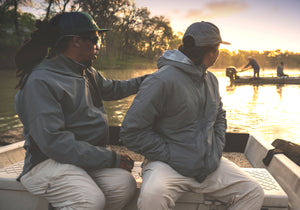Fly fishing, an angling method with a rich and intricate history, has evolved significantly over centuries. This article, inspired by Orvis, a leading UK-based brand in fly fishing equipment, delves into the historical evolution of fly fishing. We'll explore how this elegant sport has grown from its humble beginnings into the beloved pastime it is today. Join us on a journey through time, tracing the lineage of fly fishing and understanding its impact on modern angling practises.
The Origins of Fly Fishing
The Seeds in Ancient Civilisations
Fly fishing's roots can be traced back to ancient civilisations. A practise that began as a means for survival, primarily for food, soon transformed into a recreational activity. The earliest recorded mention of fly fishing is found in the work of Claudius Aelianus, a Roman author who, in the 2nd century, described Macedonian anglers on the Astraeus River using artificial flies to catch fish.
The Evolution in Medieval Europe
As we journey into medieval Europe, fly fishing began to take a more recognisable shape. The Treatise of Fishing with an Angle, attributed to Dame Juliana Berners in the 15th century, is perhaps the first comprehensive work on fly fishing. It detailed the art of making flies, rods, and lines, laying the groundwork for future innovations in fly fishing techniques and equipment.
The Renaissance of Fly Fishing
Advancements in the 17th and 18th Centuries
The Renaissance period was marked by significant advancements in fly fishing. The 17th and 18th centuries witnessed the birth of modern fly fishing in England and Scotland. Isaac Walton's 'The Compleat Angler,' published in 1653, and Charles Cotton's subsequent contributions significantly influenced fly fishing, providing detailed insights into fishing techniques and fly construction.
The Birth of Fly Fishing Clubs
This era also saw the formation of the first fly fishing clubs. These institutions played a pivotal role in the development of fly fishing culture, promoting the sport and fostering a community of avid anglers. The clubs were instrumental in refining techniques, developing new fly patterns, and conserving fish habitats.
The Industrial Revolution and Fly Fishing
Technological Advancements in Equipment
The Industrial Revolution brought about groundbreaking changes in fly fishing. The introduction of new materials like silk for lines and split bamboo for rods revolutionised the sport. These innovations made fly fishing equipment more efficient, durable, and accessible, contributing to the sport's growing popularity.
The Expansion of Fly Fishing
The Industrial Revolution also facilitated the expansion of fly fishing to new regions. Improved transportation allowed anglers to explore remote fishing destinations, and the construction of railways made previously inaccessible waters reachable. This period marked a significant expansion of the sport's geographical footprint.
The 20th Century: Modernisation and Conservation
The Emergence of Synthetic Materials
The 20th century saw the introduction of synthetic materials in fly fishing gear. The advent of nylon in the 1930s for making fishing lines and the development of fibreglass rods in the 1950s were pivotal. These materials made fly fishing gear more affordable and versatile, appealing to a broader range of anglers.
Conservation Efforts
As fly fishing gained popularity, the need for conservation became evident. Environmental awareness and the desire to preserve natural habitats led to the establishment of various conservation groups. These organisations work tirelessly to protect fish populations and their ecosystems, ensuring the sustainability of the sport for future generations.
The Modern Era of Fly Fishing
Technological Innovations
In the modern era, technological advancements continue to shape fly fishing. The development of carbon fibre rods, advanced reel designs, and refined fly lines has enhanced the angling experience. These innovations offer greater precision, efficiency, and enjoyment to anglers, whether they are beginners or seasoned experts.
The Role of Fly Fishing Communities
Today, the fly fishing community is more vibrant and diverse than ever. Online forums, social media platforms, and fly fishing clubs provide spaces for anglers to share experiences, knowledge, and passion. These communities play a crucial role in promoting the sport, educating new anglers, and advocating for environmental stewardship.
Conclusion
The history of fly fishing is a tapestry of innovation, community, and environmental consciousness. From its ancient origins to the modern technological era, fly fishing has continually evolved, enchanting anglers with its blend of art and skill. Orvis, with its commitment to quality and sustainability, is proud to be a part of this enduring legacy. As we look to the future, we remain dedicated to advancing the sport, embracing new technologies, and supporting conservation efforts to preserve the beauty and thrill of fly fishing for generations to come.

